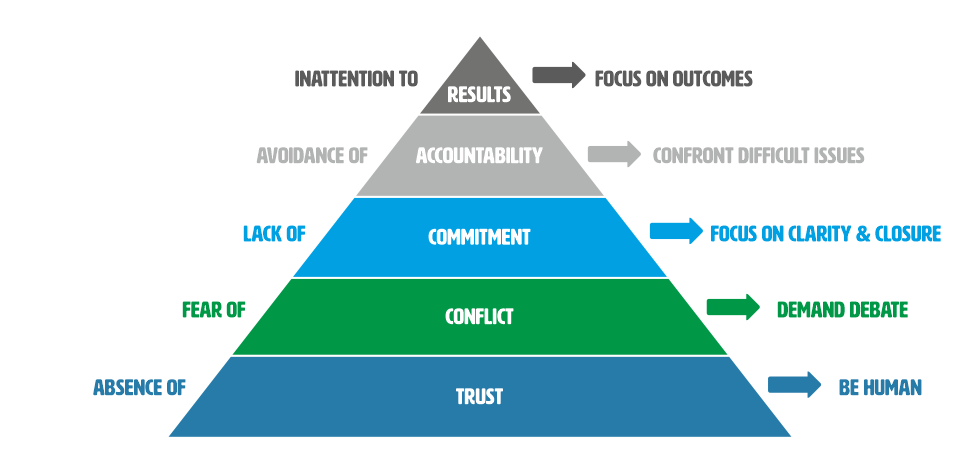🏢 9,000+ Organisations
🏆 6 x L&D/HR Awards
⭐ 4.8/5 Highly Rated
🧠 24 Years' Experience

One of the most interesting models of team effectiveness was developed by Patrick Lencioni (2005). According to him, all teams have the potential to be dysfunctional. To improve the functioning of a team, it is critical to understand the type and level of dysfunction. Like Maslow’s Hierarchy of Needs Theory (1954), there are five levels, and each must be completed to move on to the next one. It’s always a very popular topic on the Leadership Development Training we run so here’s an overview of what this model is all about.

There are five potential dysfunctions of a team in Lencioni’s model:
Dysfunction #1: Absence of Trust
This outcome occurs when team members are reluctant to be vulnerable with one another and are unwilling to admit their mistakes, weaknesses, or need for help. Without a certain comfort level among team members, a foundation of trust is not possible and Team Building will be very difficult to achieve.
Dysfunction #2: Fear of Conflict
Teams that are lacking trust are incapable of engaging in unfiltered, passionate debate about key issues. It creates situations where team conflict can easily turn into veiled discussions and back-channel comments. In a work setting where team members do not openly air their opinions, inferior decisions result. Here are some Conflict Management Exercises to help with this.
Dysfunction #3: Lack of Commitment
Without commitment, it is difficult for team members to commit to decisions, fostering an environment where ambiguity prevails. Our current VUCA Environment only magnifies. Lack of direction and commitment can make employees, particularly star employees, disgruntled and disenfranchised.
Dysfunction #4: Avoidance of Accountability
When teams do not commit to a clear plan of action, even the most focused and driven individuals are hesitant to call their peers out on actions and behaviours that may seem counterproductive to the overall good of the team.
Dysfunction #5: Inattention to Results
Team members naturally tend to put their own needs (e.g., ego, career development, recognition, and so on) ahead of the collective goals of the team when individuals are not held accountable. If a team has lost sight of the need for achievement, the business ultimately suffers.
When the team are working in harmony, these dysfunctions cease to cause problems. Lencioni’s model highlights the results when the team lack trust, and this should be the area you concentrate on the most.

We’ve so far covered the main dysfunctions of a team in Lencioni’s model. But what about how to overcome them or how to avoid them in the first place? Let’s take the dysfunctions one by one and look for creative solutions to combat them.

Solution #1: Building Trust
Lencioni’s exhortations to “be human” in the model above is shorthand for several steps that might be taken to achieve trust.
Firstly, it’s important for members of the team to honestly admit their biases and limitations. This is especially important for managers, and of vital importance when your team is working in a partly dispersed environment, with Zoom meetings being perhaps the only time your team actually “meets”. It can be a relief to say, “I’m not very good at spreadsheets; I’ll need some help”.
In a recent Forbes article, professional life coach Christine Allen recommends that Team Leaders show the way by asking for feedback at the very start. Involve the team in the process of setting goals, deadlines and milestones and you’ve already gone some way to building trust.
Engendering trust has four key components:
Once everyone’s admitted where their weaknesses lie, the team can pull together to collectively shoulder responsibilities and fill in for one another’s imperfections.
Combatting bias is important too. By bias here we mean the tendency towards certain fixed assumptions or solutions. Let’s say one team member always prefers to get deep into the figures, and fix problems by adjusting budgets. Once known, this bias might prove a good thing, if balanced by other team members taking different approaches, then the full team meeting to discuss findings.
With a combination of honesty, sharing, admitting imperfection and bias, and fair dealing, a team can learn to fully trust one another, and their managers.

Solution #2: Demand Debate
“Demand” might suggest an aggressive approach to conflict – not so. What this means is that conflicts should not be crudely shut down, nor left to simmer, but instead should be gently brought out into the open, examined and worked through until an equitable solution is found.
There is a distinction to be made between strategic disagreements and personal conflict. The latter should still be explored, but in a neutral, private setting with just the conflicting parties and their line manager, or another suitable third party, providing arbitration.
The kind of conflict we’re talking about here is where team members are butting heads over strategic direction and don’t seem to be able to get past their disagreement. The tendency will often be to “leave that for now”, which won’t solve anything. Indeed, this may cause individual team members to feel un-listened to, or even to grow resentful.
Instead, it’s important to take emotion out of the equation and give any disputes serious consideration. “Let’s talk this through” can be a powerful statement that you’re committed to getting to the other side of a conflict.
Team Effectiveness Advisor Liane Davey, writes in Harvard Business Review, that it can be useful to “start by normalizing conflicts by framing them as productive, role-based tensions.” For instance, your Marketing department is ready to launch a shiny new product line, but Research tells them the campaign won’t work for their intended audience. Davey believes there should be conflict there, with each department providing checks and balances on the other.
Similarly in a team, if you begin by creating a conflict positive environment where you welcome constructive criticism and invite opposing views, team members will overcome their natural aversion to conflict.

Solution #3: Focus on Clarity and Closure
Once you’ve established a working environment that values honesty and creative conflict, you ought to be able to obtain clarity in decision-making and close some lines of enquiry. Workable compromises can be reached, and strategies adopted. Make sure everything is written down in detail, with minutes agreed by all team members, particularly when you’ve settled areas of conflict.
If you state “let’s revisit this later” then it’s vital to specify when, how and what remedial action might be taken if the adopted strategy hasn’t worked. Certainly, team leaders must never commit to reviewing a strategy and then fail to do so – you’ll have broken trust by so doing.
Vagueness is your enemy here. Deadlines must be set, concrete milestones agreed, and all goals and objectives must be SMART ones (specific, measurable, attainable, realistic, and time-bound). The task set for each meeting must be achieved so that the team feels a sense of closure for each stage.

Solution #4: Confront Difficult Issues
Although this may sound like the approach we might take to the second dysfunction, this is more about real, concrete problems that occur, rather than momentary interpersonal or strategic conflict. Specifically, if a team member fails to deliver, or produces disappointing results, it serves nobody to attempt to sweep this under the carpet.
However, with a foundation of trust, honesty, and concrete objectives, it should become quickly apparent when things are going wrong. At this point, it’s down to the team leader to take the specific individual aside and find out why set objectives have not been fulfilled. There may be very good personal reasons for the failure, or unforeseen obstacles may have been encountered.
Group finger-pointing isn’t called for, but avoidance would be equally damaging. It’s left to the manager or team leader, therefore, to address such issues and hopefully agree a solution with the underperforming individual.
If the best solution is for the team member to leave the group, the ideal outcome would be for this individual to gracefully withdraw, announcing their decision to the team and explaining (where possible) the reasons why. This can be done without assigning blame and can provide a source of relief both to the struggling team member and the rest of the team. A team built on transparency and trust will respond empathically and pull together to repair any damage.

Solution #5: Focus on Outcomes
Hopefully, by addressing the most foundational dysfunctions in Lencioni’s model, you’ll have shaped a team that is proud of its achievements and determined to produce the best outcomes. If this is not the case, it may be worth reminding everyone periodically how important team productivity is.
It can be easy to lose the bigger picture by focusing too much on the minutiae of any given task. Team leaders may need to actively remind everyone of the greater goal at the start of meetings, as well as restating any unshakable deadlines. It may be worth revisiting the ultimate reason why the team’s task is vital. To put it another way, what will happen should the team fail to deliver?
Visualising the outcome can be helpful – having concept art, a model, a prototype, or some other visual aid to drive towards. Display this within the meeting space to make the task feel real. This is why fundraisers have giant “thermometer” boards to show how close to their goal they are getting.
While rewards for achievement can be motivating, your team really needs to see the end product of their work as a goal in itself. You don’t want your team members to be working for personal fulfilment, for a raise, or a commendation. Instead, they should be excited to see the end product executed. Instil excitement at the start of the process and follow the other tips in this article, and you should be well on your way to making this happen.
Conclusion: Teams Built on Strong Foundations Succeed
There’s a hierarchy to the way you ensure your team is most effective, and it’s demonstrated by Lencioni’s model:
A leader who pursues these five goals should be able to build a unified team, and avoid the pitfalls of Lencioni’s dysfunctions, which can understandably derail a group of disparate, fallible, humans. Tuckman’s forming, storming, norming, performing model is useful to understand this.
To learn more about the topic please take one of our Management Training programmes or Management Development Programmes.
Alternatively look at taking a Leadership Test to see your preferences. It’s a free assessment which will provide you with some valuable insights into how you manage.

Written by Sean McPheat
CEO of MTD Training and Amazon bestselling author. Sean writes about leadership, business, and personal growth, drawing on 20+ years of experience helping over 9,000 companies improve performance.
Updated on: 11 February, 2022
Originally published: 26 November, 2010
Related Articles

Search For More 